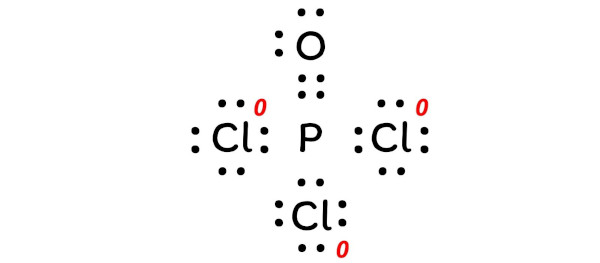
The Charge of POCl3 is 0.
But the question is how can you say that the charge on POCl3 (phosphorus oxychloride) is 0?
Well you can say this by calculating its formal charge.
So let’s calculate the formal charge of POCl3 (phosphorus oxychloride).
You can also refer to the below video from which you will learn to find charge of any ion.
Calculating the formal charge of POCl3 using lewis structure
In order to calculate the formal charge on POCl3 (phosphorus oxychloride), you should know the Lewis dot structure of POCl3 (phosphorus oxychloride).
Here is the lewis structure of POCl3.

Now using the above lewis structure of POCl3, you have to find the formal charge on each atom that is present in the POCl3 molecule.
For calculating the formal charge, you need to remember this formula;
Formal charge = Valence electrons – Nonbonding electrons – (Bonding electrons)/2
You can see the bonding and nonbonding electrons of POCl3 from the image given below.

So now let’s calculate the formal charge on each individual atom present in POCl3.
Formal charge on Phosphorus atom:
Valence electrons = 5 (as it is in group 15 on periodic table) [1]
Nonbonding electrons = 0
Bonding electrons = 10
So according to the formula of formal charge, you will get;
Formal charge on Phosphorus = Valence electrons – Nonbonding electrons – (Bonding electrons)/2 = 5 – 0 – (10/2) = 0

So the formal charge on phosphorus atom is 0.
Formal charge on Oxygen atom:
Valence electron = 6 (as it is in group 16 on periodic table) [2]
Nonbonding electrons = 4
Bonding electrons = 4
So according to the formula of formal charge, you will get;
Formal charge on Oxygen = Valence electrons – Nonbonding electrons – (Bonding electrons)/2 = 6 – 4 – (4/2) = 0

So the formal charge on oxygen atom is 0.
Formal charge on Chlorine atom:
Valence electrons = 7 (as it is in group 17 on periodic table) [3]
Nonbonding electrons = 6
Bonding electrons = 2
So according to the formula of formal charge, you will get;
Formal charge on Chlorine = Valence electrons – Nonbonding electrons – (Bonding electrons)/2 = 7 – 6 – (2/2) = 0

So the formal charge on chlorine atom is 0.
Now you can see that all the atoms of POCl3 have 0 formal charge.
This indicates that the overall POCl3 (phosphorus oxychloride) molecule also has 0 charge and hence it is a neutral molecule.
I hope you have understood the above calculations for the formal charge of POCl3 (phosphorus oxychloride).
Check out some other related topics for your practice.
Related topics:
Charge on NO3 (Nitrate ion)
Charge on SO4 (Sulfate ion)
Charge of Iodine (I)
Charge on CO3 (Carbonate ion)
Charge of Beryllium (Be)
Jay is an educator and has helped more than 100,000 students in their studies by providing simple and easy explanations on different science-related topics. With a desire to make learning accessible for everyone, he founded Knords Learning, an online learning platform that provides students with easily understandable explanations.
Read more about our Editorial process.
